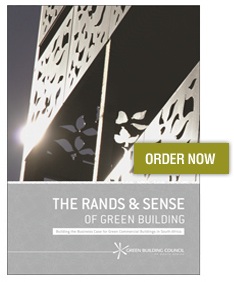
by Shane Henson — August 8, 2012—Choosing to construct a sustainable, green building is not only a good choice for the environment and for property developers, it also makes good business sense, says the Green Building Council of South Africa (GBCSA) in a new report that delves into this issue, driving home the compelling business case for green building.
The report, Rands and Sense of Green Buildings , contains evidence-based studies on the costs and benefits of green building in countries with established green building markets such as the United States and Australia, as well as local case studies, examples and anecdotal evidence, says the GBCSA. Case studies include eight Green Star SA (South Africa)-rated buildings, a number of existing building studies, and 11 international buildings.
“Results from the studies referred to in the report have shown that there is no significant cost difference between the construction of green buildings compared with conventional buildings, and green buildings achieve better investment returns and higher valuations,” says Brian Wilkinson, GBCSA chief executive. “This emphasizes that the reason most often cited for not incorporating green elements into building design—namely the increased initial capital outlay—is unfounded. A common misperception is that building green can add as much as 17% capital cost to a project. The Rands and Sense of Green Buildings report shows that this is simply not the case.”
Most of the reported premiums in the United States are between 0% and 4%. In Australia, the latest studies show that a 4-Star Green Star building is actually cheaper to build on average; and a 6-Star Green Star building—signifying “world leadership”—usually has a relatively small premium of about 6%, the report found.
The comparative immaturity of the South African green building market means there have not yet been any broad empirical studies on the capital cost impacts of green building locally. However, the local case studies documented in the report show that the South African property industry can expect cost premiums of a new commercial green building to be between 1% and 10%, according to the report.
In young green building markets like South Africa, sustainable buildings generally incur a green premium above the cost of standard construction. However, once these markets mature and green building materials and practices become more prevalent, these “new market premiums” decrease and green building can be done at similar costs to conventional buildings.
The report notes the obvious financial and environmental benefits of green building, such as lower operating costs thanks to savings on energy and water in particular. Other benefits include the enhanced marketability of green buildings as they are technologically advanced and environmentally and socially responsible.




